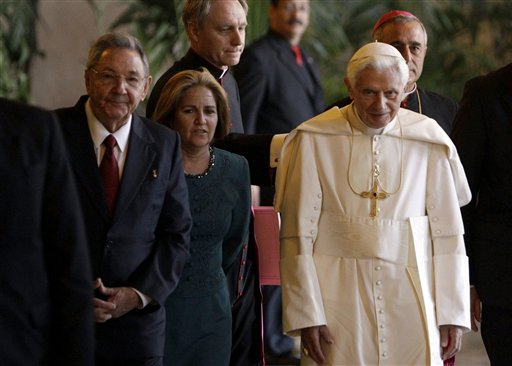The Pope’s pathetic visit to Cuba
By Achy Obejas

The Pope’s pathetic visit to Cuba
By Achy Obejas
Last week, while most of us in the U.S. were focused elsewhere, Pope Benedict XVI made a brief tour of Latin America that included a few days in Cuba. It was the second papal visit ever to the island, the first 14 years ago by his predecessor, Pope John Paul II, who famously called for “the world to open up to Cuba, and Cuba to open up to the world.”
Back then, it was a meeting of titans: The famously anti-communist pope who’d nudged along the fall of Eastern Europe’s Soviet satellites and Fidel Castro, the longest serving Marxist head of state in the world and alumnus of prestigious Catholic schools.
John Paul got various concessions from Castro in exchange for the broad symbolism of his visit. The first and most enduring was the decriminalization of religion on the island. It had never been quite illegal to be faithful in Cuba, but the faithful were denied membership in the Communist Party until just before the papal visit, and party membership had, until that point, been a requirement for upward mobility in the socialist state.
John Paul also got Castro to recognize Christmas as a national holiday. Though Cuba was nominally Catholic prior to the Revolution in 1959, even then it had been under threat by Protestant sects and santería, Cuba’s syncretic African-Christian religion. These days, less than 40 percent of Cubans identify in any way as Catholic, and Protestants continue to make inroads while santería, seen as a religion of the lower classes prior to the Revolution, is now practiced in one way or another by more than 70 percent of Cubans.
Since that 1998 encounter, and perhaps as part of a longer and blacker history on the island, the Catholic Church in Cuba has played a different role than John Paul might have imagined. For starters, the Havana Cardinal Jaime Ortega has chosen to play mediator between the Cuban government and the opposition — almost always to the benefit of the government.
A couple of years back, he helped negotiate a prisoner release for dissidents arrested during the 2003 Black Spring — but that release meant mostly deporting/exiling those troublesome prisoners and their families to Spain. The few that resisted that deportation are constantly harassed by the Cuban government.
Just recently, when 13 dissidents sought sanctuary in a Catholic Church before Benedict’s visit in order to request a meeting with him, the Cardinal called the police to have them forcibly removed. He went further and called the occupiers “irresponsible,” accusing them of turning the church into“political barricades.”
In other words, Ortega defended his calling in the thugs, which meant he had virtually no moral authority when the Cuban government, using its Mission: Impossible law of “presumption of dangerous activity,” making wholesale arrests of dissidents in advance of Benedict’s visit — not because of what they had done but in case of what they might do.
The Ladies in White — Catholic, female relatives of those arrested during the Black Spring and their supporters — were arrested by the dozen, held incommunicado, and in some cases, dropped off miles from their homes.
Young artists and intellectuals known for their opposition — members of the rock group Porno Para Ricardo, graffiti artist El Sexto, blogger Orlando Luis Pardo Lazo, filmmaker Ismael de Diego, rastafarian priest Hector Riscart and many others — were held for days without charges to keep them from disrupting the papal spectacle.
In a surprisingly blatant move, the Ministry of the Interior — Cuba’s internal intelligence agency — blocked dozens of dissidents’ phones by directing calls to their own ministry switchboard. There was no pretense or excuse: the blocked phones showed exactly where the calls where going.
None of this was unknown to Benedict, a mere shadow of his predecessor, as he was meeting with Raúl Castro, the younger and least charismatic Castro.
Benedict got all ballsy in Mexico before taking off for Cuba and said Marxism was an outdated ideology but, once on the island, he went poetic about the rights of all human beings. (The Miami Cardinal fed his flock back home a nice little speech in which he mentioned the pope’s anti-Marxist comments but, like Benedict, failed to address the thuggery that was going on as he was speaking.)
In the meantime, Benedict claimed to be over scheduled and refused to meet the Ladies in White or any other member of the opposition. But he did make time for a 30 minute unscheduled visit with Fidel Castro (excommunicated in 1962 and now a private citizen), his wife and at least one of his sons, Antonio.
One lone protestor got through security in Havana, screamed “Down with communism!” and was immediately carried away. Not an unusual move against someone who’d cause such a disruption, but a week later, no one knows where this man is. Moreover, as he was being pulled away, he got smacked in the head with a folded cot by a Cuban Red Cross worker — yes, a Red Cross worker. Have Catholic authorities made the slightest move, if not to free this man — now identified as Andrés Carrión Alvárez — at least to find out what happened to him?
In the end, Benedict was on such good enough behavior, turning a blind eye to Raúl’s very bad behavior, that he was rewarded with two small prizes: his speeches broadcast on state media and the recognition, this year only, of Good Friday as a national holiday.
In the end, Benedict failed to hear the most important voices on his trip: there, as his last mass came to a conclusion, the Cubans in his flock softly chanting “libertad, libertad.”